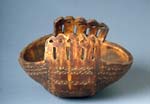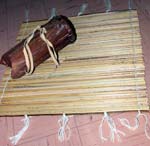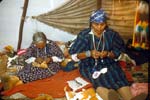 | Beading Moccasins,
ca. 1950s |
There are so many ways we celebrate the beauty we see in the world, the beauty brought forth by the Creator. Throughout the year and with our families gathered around, we sing songs and dance in our beaded regalia at our powwows. During the summer we parade on our finest horses, with both our horses and ourselves adorned in our best beaded regalia and martingales. Many of the songs are very ancient, handed down from generation to generation within our families, and the intricate patterns of beaded designs on our shirts and dresses reflect the world of the animals and plants. See the Powwow page. The laughter, suspense, and excitement from the stories of Coyote and the other Animal Peoples continues as our grandmothers and grandfathers retell with animation these stories for our children. See the Oral Traditions. And many of our contemporary artists are finding new ways to express our thanks, as in the masks made by Lillian Pitt or the paintings of Roxanne Chinook, for example. Our aesthetic appreciation of our world is found in all we do, as it is sometimes difficult to separate art from our way of life. Our finely-designed baskets, taking hours to weave, are also the containers we use to hold the berries and roots we pick and dig.
|
|
Meet contemporary Warm Springs artist Lillian Pitt as she talks about her masks of clay and metal, and the traditional inspirations for them. Part 1. (From the video, Faith To Continuance, by David Schneiderman and Penny Phillips. © Mimbres Fever 2002. Used by permission.) |
|
|
Lillian Pitt continues talking about her art, and of the the 7-foot Salmon Drying Rack she did with fellow artist, Ken MacKintosh. Part 2. (From the video, Faith To Continuance, by David Schneiderman and Penny Phillips. © Mimbres Fever 2002. Used by permission.) |
The making of baskets and bags is one of the wonderful examples of our continued celebration of beauty and the elaborate knowledge it takes to create these works of art. These are skills we pass on to our daughters at an early age, with twining and coiling the two principle techniques we use to make baskets. Pat Courtney Gold (interview below) will also explain the technique of twining unique to the Wasco weavers. When we gather the materials used to make our baskets, we offer prayer for the use of the plant fibers and give thanks to the Creator.
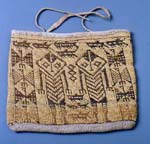 | Flat Twined Bag,
ca. 1800s |
For our twined bags, such as flat cornhusk bags or round “sally” bags, we would gather the fibers of Indian hemp (giant dogbane), which grows along the rivers. The fibers of the hemp are surprisingly strong and are also insect repellant, and are ideal for food storage containers. We also use hemp string to make our fish nets and to sew our tule mats together. The twinning technique involves taking hemp strips horizontally laid (known as weft) and interlacing them with vertically laid strips (known as wrap), to create a soft and flexible basket. A method of false embroidery is also used, taking dyed cornhusks or colored wool string and weaving it into a colored pattern on the basket. The use of cornhusks was, of course, only began after the arrival of corn farming and access to this material, as early as the 1800s.
|
|
Meet contemporary Wasco artist and basket weaver Pat Courtney Gold as she talks about the inspiration for her baskets and the revival of the old techniques. Part 1. (From the video, Faith To Continuance, by David Schneiderman and Penny Phillips. © Mimbres Fever 2002. Used by permission.) |
|
|
Pat Courtney Gold demonstrates how to weave a basket and talks about the special meaning of the Lewis and Clark replica basket she has made. Part 2. (From the video, Faith To Continuance, by David Schneiderman and Penny Phillips. © Mimbres Fever 2002. Used by permission.) |
Using the twining method, we also made basket hats, sometimes out of straw grass. These hats were once part of our women’s everyday clothing, but today are only worn during special occasions, such as a powwow, a parade, a memorial, and during one of our Root Feasts. If you look closely on the top of these hats, some have a feather or two on top. One feather will indicate the wearer as a single women, while two feathers means she is married. Not all basket hats have feathers atop them, but they are just as meaningful for their wearers.
|
|
Be introduced to the Cornhusk Bags and their various styles and uses. Please note: the use of the term "Nez Perce bags" is generic, as the Wasco and Warm Springs people also made them. (From the video, Faith To Continuance, by David Schneiderman and Penny Phillips. © Mimbres Fever 2002. Used by permission.) |
Our coiled baskets are made from red-cedar roots (the foundation coil) and sometimes willow, patterned with dyed beargrass and cedar-root bark to form the designs on them. Because these baskets were very rigid, they were ideal for gathering berries (so they would not be crushed while being carried) and for storing foods over long periods of time. Some of our coiled baskets were so tightly fashioned that they could hold water and we could even boil water in them (by adding heated stones). During our annual Huckleberry Feasts, the ceremonial pickers bring into the community longhouse the berries in large coiled, fancy baskets. The Wascos are well known among other tribes for their designs of human and animal motifs, and complex geometric patterns on their bags.
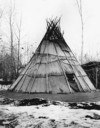 |
Tule-mat Lodge,
c. 1905
|
In addition to the fine baskets we have continued to weave, the use of reeds and beads have also been important in our people. Gathered from along the shores of some rivers and lakes, tule reeds were tied into large mats, attached to poles, and extensively used in the construction of our lodges. Easily rolled up, our lodges could be taken down and transported to different locations as the seasonal cycle dictated. During the summer, a cooling breeze was allowed to flow through the tule reeds, but during the winter, the moisture expanded the reeds to render them water-proof. Today, we still use the tules as ceremonial mats at our feasts and other special occasions.
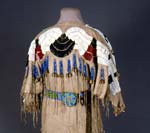 | Beaded Dress,
ca. 1800s |
After the introduction of European trade beads, the images of nature, such as intricate floral or animal designs, as well as geometric patterns, soon found their way onto our clothing and dance regalia, bags, and horse gear, such as martingales. While in the past beading was done primarily by women, today, both men and women bead.
Please note that the art of Roxanne Chinook, Pat Courtney Gold and Lillian Pitt reflects aesthetic elements and visions that integrate the images of their "traditional" heritage along with their personal innovations. Their art is a "living" and dynamic expression of both traditional values as well as contemporary creativity, and not simply a replication of the artistic forms and designs of 200 years ago.
© Confederated Tribes of Warm Springs 2003
< previous | next >
|




